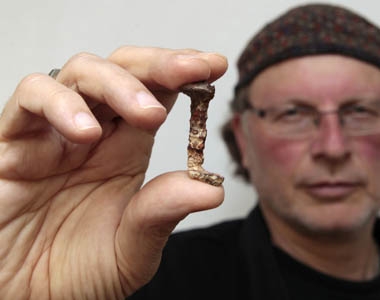The Nails of the Cross: A Response to the Criticisms of the Film
By: Director/Producer Simcha Jacobovici
As many people know, my colleagues and I recently made world headlines by claiming that we may have identified two of the nails used in Jesus’ crucifixion. My documentary film “Nails of the Cross” and coverage of it, generated by a press conference in Jerusalem(April 12, 2011), caused a firestorm of media and especially internet criticism, some of it vicious.
Although I have never responded to ad hominem criticisms, I’ve decided to make an exception this time. My decision is based on two factors: first, most people are confused about the facts of the case. Second, as far as I’m concerned, the tone of the debate has slipped into the pseudo-science of anti-Jewish caricature of 1930’s Germany, and I feel it
is my duty as a Jew, a journalist and a human being to stand up and expose the culprits.

I will divide my comments into matters of substance and matters of style. First, the substance:
The Argument
The essence of the thesis presented in my film is as follows:
1. In 1990, a tomb was found in east Jerusalem that most – but not all – scholars agree is the burial cave of the High Priest Caiaphas who, according to the Gospels, was implicated (around 30/31 C.E.) in the arrest and crucifixion of Jesus of Nazareth.
2. In the tomb, archaeologists identified 12 ossuaries, or bone boxes, some pottery, a glass perfume bottle, a coin in one of the skulls and two Roman nails.
3. According to the Mishna (Mishna Shabbat 6.10; see also J. Talmud Shabbat 6:9, 7c-d, B. Talmud Shabbat, 67a), people were using nails that had been involved in crucifixion as amulets and for the purpose of magical healings.
4. Since Caiaphas is known to history for one thing and one thing only i.e., his involvement in the crucifixion of Jesus, and since crucifixion nails were regarded as amulets, it seems reasonable to connect the nails found in the Caiaphas tomb with two of the nails used to crucify Jesus.
I think the above, at least as a starting hypothesis, is pretty straightforward. Based on this thesis, I asked the Israel Antiquities Authority (IAA) for access to the “Caiaphas nails.”
They informed me that the nails had gone missing. They had not been photographed, measured, drawn or properly documented. Also, to this day, the IAA has no knowledge as to their whereabouts.
As shown in my film, I believe that I have located them.
My thesis, however, is not affected by my claim to have rediscovered the nails in an anthropology laboratory at Tel Aviv University. So let’s return to the thesis and the criticisms leveled against it:
1. To my first point i.e., that the tomb in question belonged to the High Priest Caiaphas, there are objections, but there is no real controversy. It’s true that some people say that the tomb may not have been associated with the notorious High Priest. Of course, no one can say with absolute certainty that it is his tomb. There is rarely, if ever, absolute certainty in archaeology. Nonetheless, there is general agreement amongst the experts that the tomb in question did belong to the High Priest mentioned in the Gospels.
For example, Israel Museum curator David Mevorach says on camera that he believes that the “Caiaphas” who was buried in the tomb, and whose ossuary is marked with the inscription “Joseph son of Caiaphas,” is the High Priest of Christian Bible infamy.
Mevorach gives several reasons. First, out of some 3,000 ossuaries thus far excavated in Israel, the name “Caiaphas” appears only in this tomb. In other words, it is a very, very rare name. Second, there was a very elaborate ossuary found in the tomb. That ossuary is now on display at the Israel Museum where it is presented as Caiaphas’ ossuary. It is very ornate, and this is befitting a High Priest. Third, a coin found in the tomb is dated to 42/43 C.E., the reign of Herod Agrippa I, so the tomb is right for both date and location.
The recently published Corpus Inscriptionum Iudaeae/Palaestinae by Hannah Cotton et. al. (De Gruyter, 2010) sums up the discussion this way: “… the present ossuary and the entire tomb could be associated with Joseph Caiaphas, the High Priest 18-36 C.E. known from Josephus and the New Testament” (p. 483, italics in the original).
The words “the entire tomb” are very significant and I will refer to them later. For now, suffice it to say, that some of the people who are most critical of me with respect to my thesis on the nails are the very same people who dentified this tomb as the probable, or possible, tomb of the High Priest Caiaphas. For example, Greenhut, the lead
archaeologist on this excavation, now publicly fudges the connection between the tomb and Caiaphas. But he had this to say in the official IAA Hebrew report published in 1991:
“it is almost certainly the name of the family of the High Priest ‘Caiaphas,’ from whose home the arrested Jesus was transferred to Pontius Pilate” (Hadashot Archiologiot Tsadi/Zayin [97], IAA, 1991, p. 72, emphasis added, my translation). Even Mr. Joe Zias, the former anthropologist at the IAA, and my most intemperate critic, in 1992 stated that this cave “appears to be the tomb of the high priestly family Caiaphas” (‘Atiqot 21, 1992,
p. 79).
Click here for the full article with the rebuttal.

